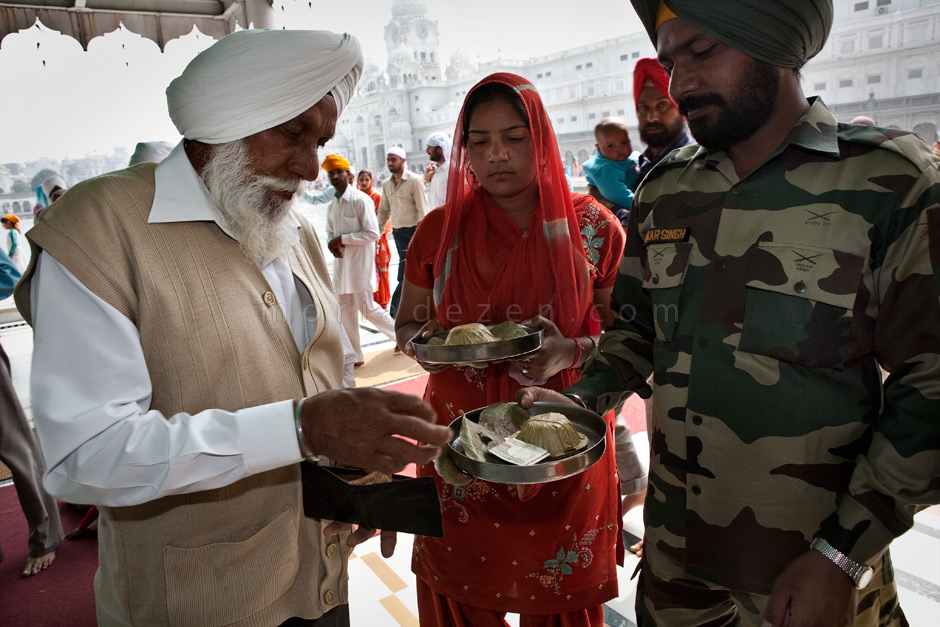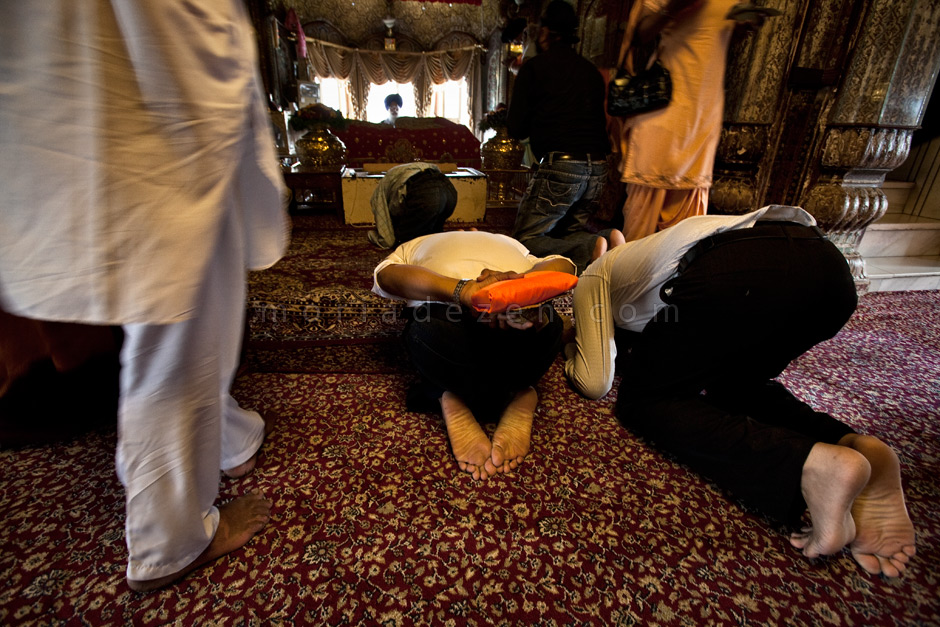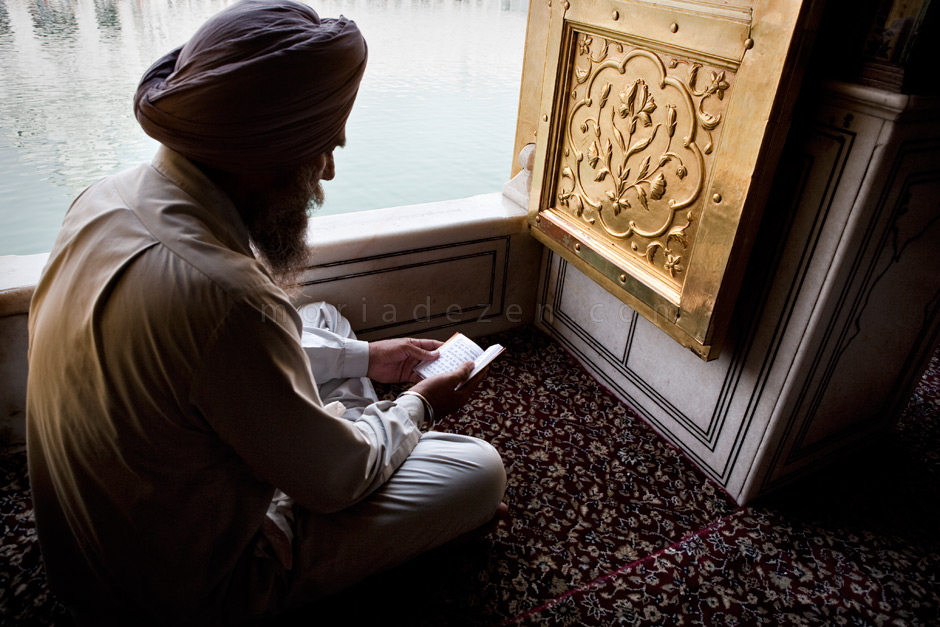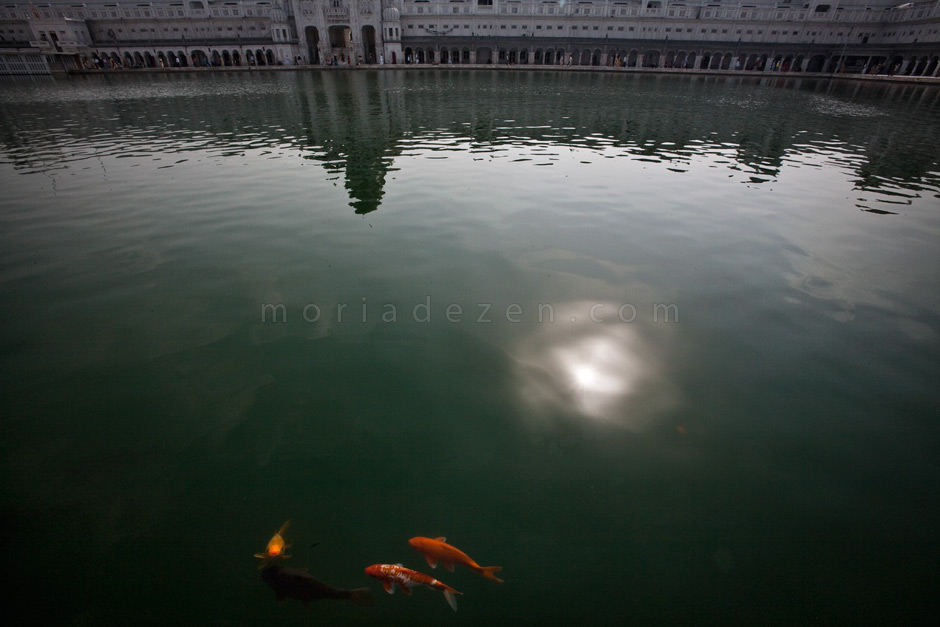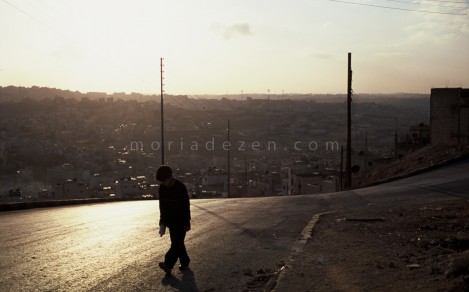English
In the heart of Amritsar old town, in the state of Punjab, in India, at the border of Pakistan, it is located the Golden Temple built on the water dell’Amrit Sarovar, the sacred lake from which the town takes its name (literally: Pond of Nectar of Immortality). The real name of the Golden Temple is Harmandir Sahib, meaning Temple of God because it is made from the words Hari (God) and Mandir (Temple). It is a two-floor marble building and its famous dome, entirely covered with pure gold fused with copper, represents an inverted lotus flower, a symbol of Sikh involvement in the problems of the world. It is the most sacred place of worship of the Sikh religion and is considered a place of pilgrimage where one should go at least once in a life to pray. Today it has become a touristic attraction in the world. In some periods of the year during important religious festivals, visitors and pilgrims reach te number of two million people. Outside the temple, Amritsar is just one of the many dusty and crowded Indian cities.
The Golden Temple has four entrances that symbolize the importance of acceptance and openness (a concept taken from the tent of Abraham in the Old Testament, also opened on all four sides to welcome travelers from all directions). All Sikh temples in the world follow the traditional rule according to which everyone is free to access from one of the entrances. Even for the Harmandir Sahib, anyone wishing to enter may do so freely, without restrictions due to religion, color, creed or sex. You enter barefoot, and your head covered with a veil as a sign of respect, after having completed the rite of the washing of the feet. You enter the main building across a causeway always crowded with faithful in the queue, called the Guru’s Bridge. Once inside the pilgrims offer to servants the soft and sweet prasaad which after they distribute half of it to visitors when they come out of the temple. All Sikh temples have a common kitchen. In that one of the Golden Temple, each day volunteers prepare about thirty thousand free meals. The food is simple (chapati and lentils) and is prepared and served with order and discipline. Inside, in the same key positions of the temple, four priests read non-stop Punjabi songs taken from the sacred text of the Sikhs and their voice, widespread over the speakers, gives solemnity to the place. During the day the original Granth Sahib book (the Holy Book), is kept in the temple under a pink cloth and every night at 22 pm is taken back to Akal Takhat with a ceremony. This building is the meeting place for the Shiromani Gurdwara Prabandhak Committee (SGPC), the Sikh parliament, the organization responsible for the safekeeping of Sikh temples in India.
The area where Amritsar arose was assigned to the Sikhs of the Mughal emperor Akbar. Starting from 1588, the year when the first stone was laid, the temple saw the involvement of three great Gurus of Sikhism for its realization. The fourth great Guru Ram Das (1534-1581), dug the pit that gave the city its name. The temple was completed only in 1601. In the course of its history, starting from 1761, the temple was the target of looting and destruction. It was rebuilt in 1764. During the riots that followed the division of India in 1948, Amritsar was again the scene of terrible events that shook the Punjab. Later, in the Eighties, the Golden Temple was occupied by some extremists who, led by Jarnail Singh Bhindranwale, had the objective of establishing a separate nation Sikhs in the Punjab province (the so-called Khalistan). In June 1984 the Indian Army led his troops into the Golden Temple to end the occupation of the separatists accused of terrorism. A military operation that caused the deaths of hundreds of Sikhs. Many of them regarded the attack as a desecration of their holiest shrine and their anger had deep and dramatic consequences: the assassination of Prime Minister Indira Gandhi by two of her Sikh bodyguards. Two years later was killed also the leader of the Indian Army, the General who led the operation. The assassination of Mrs. Gandhi gave rise to anti- Sikh riots on a national scale; it is estimated that have been killed about ten thousand Sikhs. The Golden Temple suffered considerable damage as a result of the entry of military tanks, but were later repaired and today the situation has returned to normality.
MDZ
Italiano
Nel cuore della città vecchia di Amritsar, nello Stato del Punjab, in India, al confine col Pakistan, si trova il Golden Temple, eretto sulle acque dell’Amrit Sarovar, il lago sacro da cui la città prende nome (letteralmente: Laghetto del Nettare dell’Immortalità). Il vero nome del Tempio d’Oro è Harmandir Sahib, che significa Tempio di Dio perché composto dalle parole Hari (Dio) e Mandir (Tempio). È un edificio in marmo a due piani la cui famosa cupola, interamente ricoperta d’oro puro, fuso col rame, rappresenta un fior di loto rovesciato, simbolo del coinvolgimento dei sikh nei problemi del mondo. È il luogo di culto più sacro della religione Sikh e considerato un luogo di pellegrinaggio in cui recarsi almeno una volta nella vita per pregare. Oggi è un’attrazione turistica di livello mondiale. Tra visitatori e pellegrini, in alcuni periodi dell’anno durante importanti feste religiose, raggiunge anche i due milioni di persone. Fuori dal tempio, Amritsar è una delle tante polverose e affollate città indiane.
Il Golden Temple, ha quattro entrate che simboleggiano l’importanza dell’accettazione e dell’apertura (concetto ripreso dalla tenda di Abramo nel Vecchio Testamento, aperta anch’essa su tutti e quattro i lati per accogliere i viaggiatori da tutte le direzioni). Tutti i templi sikh nel mondo seguono la regola tradizionale secondo la quale ognuno è libero di accedere da una delle entrate. Anche nell’Harmandir Sahib chiunque ha voglia entrare può farlo liberamente, senza limitazioni dovute alla religione, al colore, al credo o al sesso. Si entra scalzi e ci si copre la testa con un velo in segno di rispetto, dopo aver compiuto il rito del lavaggio dei piedi. Si accede all’edificio centrale, attraversando una strada rialzata sempre gremita di fedeli in coda, chiamata Guru’s Bridge (Ponte del Guru). Una volta dentro i pellegrini offrono agli inservienti del soffice prasaad dolce e questi ne distribuiscono metà a tutti i visitatori quando escono dal tempio. Tutti i templi sikh hanno una cucina comune. In quella del Golden Temple alcuni volontari preparano ogni giorno circa trentamila pasti gratuiti. Il cibo è semplice (chapati e lenticchie) e viene preparato e servito con ordine e disciplina. All’interno quattro sacerdoti posizionati in altrettante posti chiave nel tempio, leggono senza sosta brani in punjabi tratti dal testo sacro dei sikh e la loro voce, diffusa dagli altoparlanti, conferisce solennità al luogo. Durante il giorno l’originale del Granth Sahib (Libro Sacro), è custodito nel tempio sotto un panno rosa e ogni sera alle ventidue viene riportato con una cerimonia all’Akal Takhat. Questo edificio è la sede in cui si riunisce lo Shiromani Gurdwara Prabandhak Committee (SGPC), il parlamento sikh, l’organizzazione responsabile della custodia dei templi sikh in India.
Il luogo in cui sorge Amritsar fu assegnato ai sikh dell’imperatore Moghul Akbar. A partire dal 1588, anno in cui fu posata la prima pietra, il tempio vide il coinvolgimento di tre grandi Guru del Sikhismo per la sua realizzazione. Il quarto grande Guru, Ram Das (1534-1581), scavò la cisterna che diede il nome alla città. Il tempio venne completato solo nel 1601. Nel corso della sua storia, a partire dal 1761, il tempio fu bersaglio di saccheggi e distruzioni. Venne ricostruito nel 1764. Durante i disordini che seguirono la scissione dell’India nel 1948, Amritsar fu ancora teatro di terribili eventi che sconvolsero il Punjab. Successivamente, negli anni Ottanta, il Golden Temple fu occupato da alcuni estremisti i quali, guidati da Jarnail Singh Bhindranwale, avevano l’obiettivo di costituire una nazione sikh indipendente nella provincia del Punjab (il cosiddetto Khalistan). Nel giugno del 1984 l’Esercito indiano condusse le sue truppe nel Tempio d’Oro per far cessare l’occupazione dei separatisti accusati di terrorismo. Una operazione militare che provocò la morte di centinaia di sikh. Molti di essi considerarono l’attacco come una profanazione del loro santuario più sacro, e la loro rabbia ebbe profonde e drammatiche conseguenze: l’assassinio del premier Indira Gandhi da parte di due delle sue guardie del corpo sikh. Due anni dopo fu ucciso anche il capo dell’Esercito indiano, il Generale che condusse l’operazione. L’assassinio della signora Gandhi diede origine a sommosse anti-sikh su scala nazionale in cui si stima siano stati uccisi circa diecimila sikh. Il Golden Temple subì ingenti danni a causa dell’ingresso dei carri armati militari, ma furono successivamente riparati e oggi la situazione è tornata alla normalità.
MDZ








